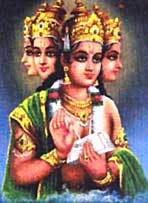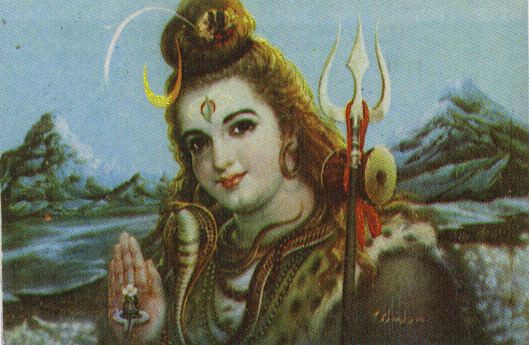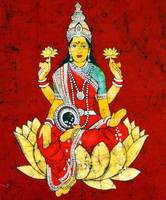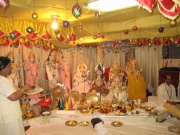Hinduism
From Seminar 2: The Peopling of New York City
Contents |
Introduction
This section looks at Hinduism of West Indies in Flatbush community. How it changed and if people still follow there religion in NYC. Internet research, participation/observation in Brooklyn Hindu Temple and interview of its Pandit (priest) were done to acquire the information. Also, background information is provided to better understand the changes as well as the religion itself.
Enjoy Gayatri Mantra
Video is bad but the singer is awesome! I recommend to turn it on before reading.
Hindu Devas (Gods)
Sanskrit (Vedic) Devas
Hindu Trinity:
<center>


Lord Brahma is considered to be Lord of Creation. He is represented as four-headed, four-armed and red-skinned god that carries no weapons unlike other gods. Instead, he holds a cup, a bow or a book of prayers, a spoon and Vedas (the knowledge) (Cristescu).
Lord Vishnu is the preserver of life. He has strong principles of order, righteousness and truth making him also the Lord of Truth. He is famous for his ten avatars: "Matsyavatara (fish), Koorma (tortoise), Varaaha (boar), Narasimha (the man lion), Vaamana (the dwarf), Parasurama (the angry man), Lord Rama (the perfect human of the Ramayana), Lord Krishna (the divine diplomat and statesman), and yet to appear ... the Kalki avatar" (Das, "Lord Vishnu"). It is believed that he does so to preserve peace in the world. The Lord is portrayed with dark complexion and four arms.
Lord Shiva is the Lord of Destruction. "Shiva is the god of the yogis, self-controlled and celibate, while at the same time a lover of his spouse (Shakti)" (Gruenwald and Marchand). Thus, he is perceived to be responsible for getting rid of old habits (destruction of them). He often hold his trident and surrounded by snakes to show that he is beyond death. The Lord also sits or wears tiger skin that is a symbol of mind.
It is hard to say who exactly of them created vedas (vedic knowledge) because some sources say that Lord Vishnu and Lord Shiva created
them while Lord Brahma holds them while others say that Lord Brahma is the creator and holder of the knowledge. It is certain,
however, that these gods are connected to each other as a cycle of birth, life and death. So, they can be considered as the same
"Sacred Force" that is responsible for this world.
Other popular Vedic Devas:
Mata (mother) Lakshmi is the goddess of wealth and prosperity. It is not only on the material level though. She is also responsible for spiritual and mental well being. The goddess is always perceived to have golden complexion with fours arms that symbolize "dharma or righteousness,kama or desires, artha or wealth, and moksha or liberation from the cycle of birth and death" (Das, "Lakshmi: Goddess of Wealth & Beauty!"). She often has a jar of gold coins or coins falling from her hands, which shows that those who worship Lakshmi get wealthier. She is also thought to be an eternal consort of Lord Vishnu.
Lord Ganesha is the Lord of success and remover of evils and obstacles. "He is also worshiped as the god of education, knowledge, wisdom and wealth" (Das, "Ganesha: Lord of Success"). The Lord's head is the symbol of Atman(soul), "which is the ultimate supreme reality of human existence, and his human body signifies Maya or the earthly existence of human beings.' The elephant head represents wisdom while its trunk denotes the sound/symbol Om of cosmic reality.
Goddess Saraswati is a daughter of Lord Shiva. She resides over wisdom, art and music. “It is believed that goddess Saraswati endows human beings with the powers of speech, wisdom and learning” (Das, "Birthday of the Goddess of Wisdom"). Her four arms represent mind, intellect, alertness and ego and white dress stands for purity. Her devoted worshipers are saintly people, people who strive for spirituality, educated individuals and those with principles.
Village deities (devates):
Ones of the most popular local deities on the Caribbean islands, specifically on Martinique island, are Marie-aimee, Maldevidan, and Munadian. Marie-aimee is one of the most prominent South Indian devates and is especially associated with diseases. These gods that are in heritage of those who call themselves East Indies are more likely influenced by christianity Maldevidan is likened to a Christ where as Marie-aimee is associated to Virgin Mary (Ramdin 2000, Horowitz 1963).
History of Immigration to West Indies
Slavery was abolished on West Indian islands in XIX century and so British sugar planters needed new sources of cheap labor. One of such sources was Indian labor. They were required to work on plantations for five years in order to fulfill contracts. After the fulfillment they could do regular jobs, earn more money and migrate back or stay if Indians wanted to. By the end of this system in 1917 West Indies received more than two million Indians; some of them perhaps returned to India.
However, why did so many Indian people agreed to such conditions? At that time the country was in huge economical crisis. Starvation, mass unemployment and other factors caused them to comply with the conditions. Most of them came to earn money and go back to India. However, they found living conditions better on Caribbean islands rather than on the ancestral ground and stayed there.
The background of all who came to Caribbean islands is very diverse geographically as well as socially. Trinidad and Guyana in early stages was receiving people from Tamil and Telugu-speaking South India. The same goes for French territories of Guadelupe and Martinique. The mainstream of immigrants to the British and Dutch territories was from the Northeast India, especially from Bihar and Eastern Uttar Pradesh. Generally, those who came were of low status or low castes but Brahmins also found their way to West Indies. According to an interview of Brahmin in Brooklyn Hindu temple Brahmins had to hide their true status in order to be able to immigrate since they were thought to be troublemakers by the planters.
Differentiation from India
Unification of Practices on the Caribbean Islands
Presence of other religions made Indian people aware of their minority status that made them more united in terms of worship. Other people of the Caribbean islands were looking down upon Indians no matter what caste they belonged to. So, people became more unified in social matter, too. Brahmins gradually started performing ceremonies for poor people as well. They unified their practices forming Brahmin-led national associations in order to counter Arya Samaj’s missionaries — he was North Indian reformist of the religion.
Other Religions' Influences
The low-caste communities, on the other hand, lacked Vedic knowledge and some of the symbols of Christianity mixed into the ceremonies for village deities (Horowitz 1963: 340). They were often identified with Christian celestial hierarchy and the sign of the cross was used in their ceremonies.
My experience in Brooklyn Hindu Temple
Participation/Observation of Ceremonies
I went to the Brooklyn Hindu Temple twice. The first time I came there they were having special puja (offering) ceremony for Rama after 12p.m. But before it happened, people and the priest were invoking other deities including Lord Brahma, Lord Vishnu, Lord Shiva and Mata Lakshmi. After invoking a god or a goddess into small figurine with their chants few of the followers were symbolically cleaning his/her “body” by pouring water on the stone called Shiuling for Lord Shiva and murti or statuettes for other deties. Then they emblematically gave him/her fresh clothing by putting small mantle over the shoulders and finally presented fruits, ghi, which is purified butter prepared by slightly boiling regular butter about an hour until it becomes transparent without any impurities during Purnima (full moon), and ganga (water from sacred river Ganges) as food and drink. During these pujas for every deity the priest and “friends and followers,” as the priest called people, and I were chanting and singing mantras and chants. When chants were sang few teenagers were playing musical instruments and during the special puja for Rama one man was playing drums. In puja with the stone, first water was poured and then panchamrit (where panch means five and amrit means “drink of immortality”), which consists of milk, honey, sugar, ghi and ganga. After this kind of puja there was another one where Brahmin was chanting mantras and at the word Svaha in the mantras repeated by everyone, two followers were putting pieces of food, incense, grain and pouring small amount of water and ghi into fire. After this, one person would go around and put ashes mixed with incense on foreheads of people and mine, too. Finally, those who wanted could go to gods’ statuettes with fire on a golden plate and after giving their respect to the gods go around people giving their respects and “light up their tips of the tongue,” so there would be light and warmth inside and outside of the people. These pujas where done the second time I was there except that a young boy was taught how to do them correctly. It was a new experience for me and I enjoyed it seeing the warmth and kindness of people. I tried to sing the mantras I knew and followed those which were easy to follow.
Interviews
I interviewed two Brahmins from the Temple. One of them allowed me to interview him when I said why I needed it and suggested me to take pictures. Another one accepted the consent form for the interview and pictures. However, upon asking the question of how Hinduism changed on the Caribbean islands if it did the first one said that it almost did not change except small nuances “due to life on the Caribbean Islands” while another one provided a lot of information and described me the pujas.
The changes are on his opinion due to the way of Indian immigration to the Caribbean islands, oppression of the Hindu language and religion and missionaries of Christian religion. He told me that when people were accepting to work with tiny wages on the Caribbean islands Brahmins were not allowed to migrate because they did not want to work on plantations as regular folk, so “they needed to hide their identity” in order to be able to migrate. Pandits brought books and rituals with them. Due to missionaries and lack of jobs for non-Christian, people had to take Christian names, learn English and go to Churches in order to get a decent job. “If you want to be a teacher you have to learn English and accept Christianity,” how the Pandit described the situation. “Later, young people refused to learn Hindu, so very few of them knew it and even fewer knew how to write.” So, the preaching, so to speak, happens in English. After these words I asked, “Is this the reason why when you use Sanskrit and Hindu words you explain their meaning?” and he answered positively. When I was asking him about the puja with fire where I heard chants with different names I said “chants for different gods” and he corrected me saying, “There is only one God. We call God with different names when He does different jobs. Same as one person can be a man, a husband or a teacher depending on a situation.” I remembered his words during his preaching, “God loves us so he takes the form of what we want him to be. He can be man so why can’t he be woman as well?” All these “incarnations” of God are to fulfill certain jobs to make “His children happy.”
Another difference besides the factors mentioned is the number of people in the Temple. "When I was in India for a year, there they have huge Temples with a lot of followers present. So, the devotee in India is more of a witness," said Brahmin. "While in West Indies devotees perform the ceremonies with a priest."
"Most Hindu followers are from Trinidad, Guyana and Suriname. Other West Indian islands also have Hinduism."
Second Generation in the U.S.
Another question I asked was concerning Second generation of West Indies in the NYC. The answer I received was the following: "Ten years earlier little ones didn't want to wake up early but now they go to temples and wish to learn their background."
In the end of the interview he said, "Visit India. It is a fascinating experience," and added, "Also, visit Temples in Queens because this is a transitional neighborhood. All people want to own a house so, they come here, earn money and go to Queens."




